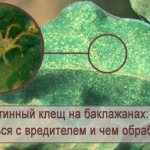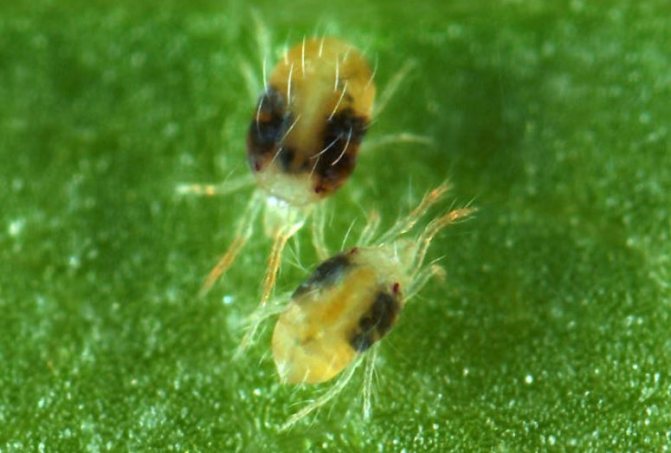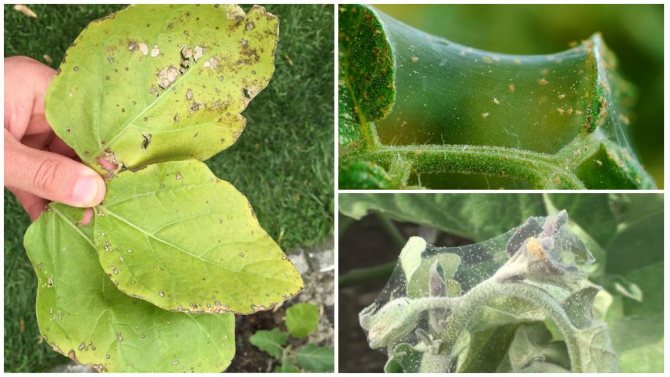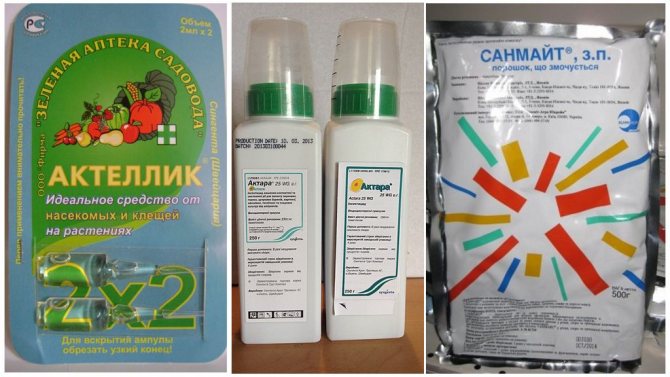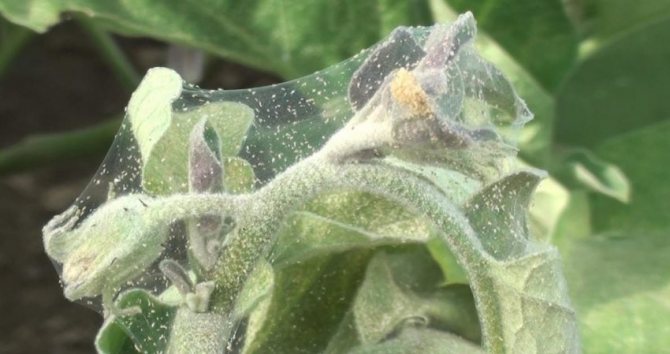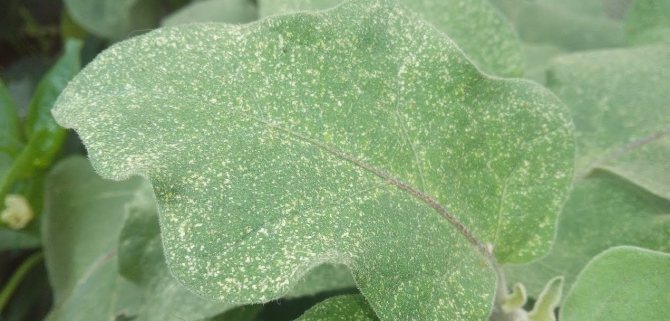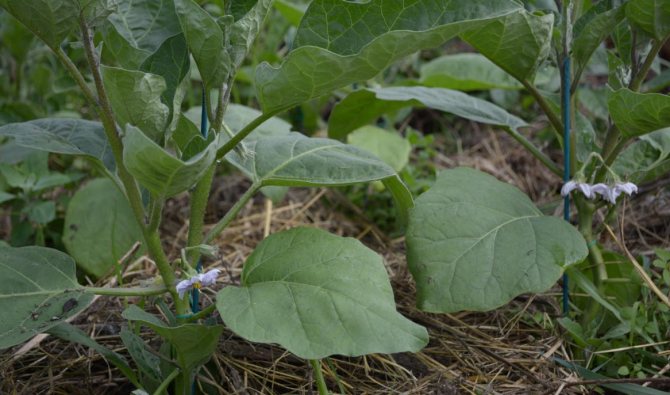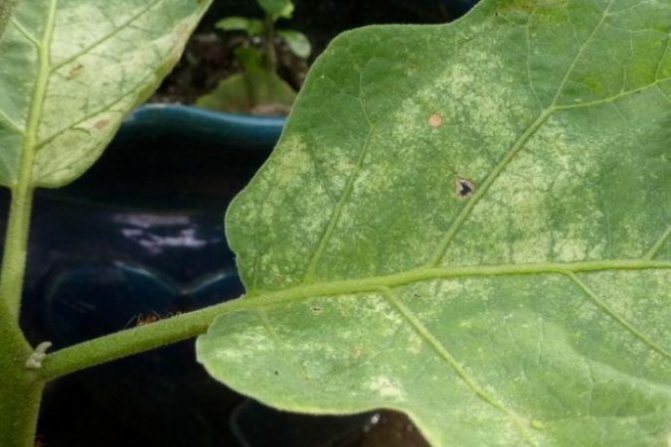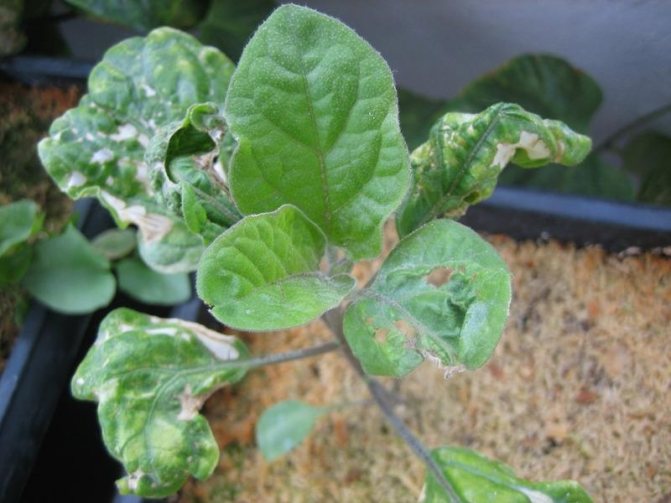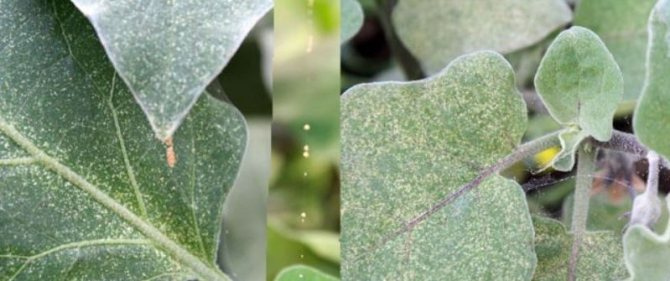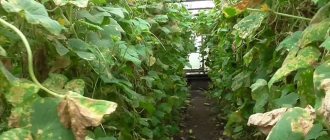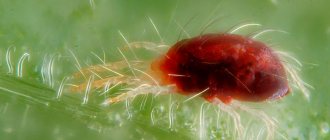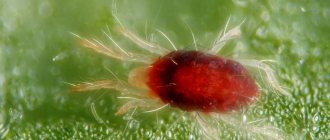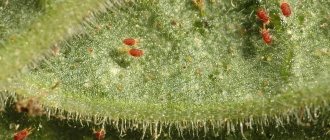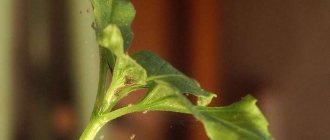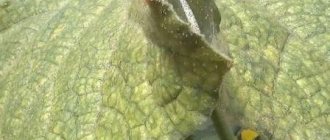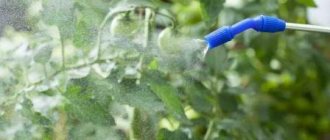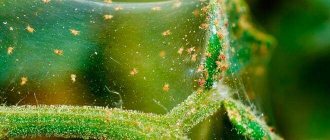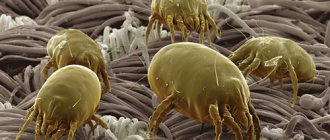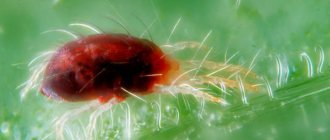When a spider mite appears on eggplants, urgent measures must be taken to eliminate it. Among the ways how to deal with this pest, one can single out folk remedies, the use of biological products and chemicals. The choice depends on the degree of distribution of the tick and the stage of development of the plant.
Signs of a spider mite on eggplants
Visible signs of damage to eggplants by a spider mite can be seen when the pest has already thoroughly settled on the bush. Due to the tiny size of this arthropod, it is difficult to identify immediately. The backs of the leaves are the first to suffer, then the pest moves to the stems and young shoots.
The presence of a mite is determined by the appearance of the eggplant:
- tiny light or colorless dots appear on the surface of the leaves, as they are affected, they grow together into a faded marble pattern;
- brown spots appear on the leaf plates, which dry out over time and turn into small holes;
- on the underside of the leaves, you can see a thin cobweb, which, if severely damaged, envelops the bush almost entirely;
- leaves gradually lose turgor;
- from the affected leaves, the tick passes to the fruits, lightened specks also appear on them;
- eggplants lose their juiciness and firmness.
In just two weeks, a spider mite can completely destroy a plant. The growth of eggplant at first slows down, it looks depressed and painful, at the last stage the rhizome dries out, and the bush can no longer be saved.
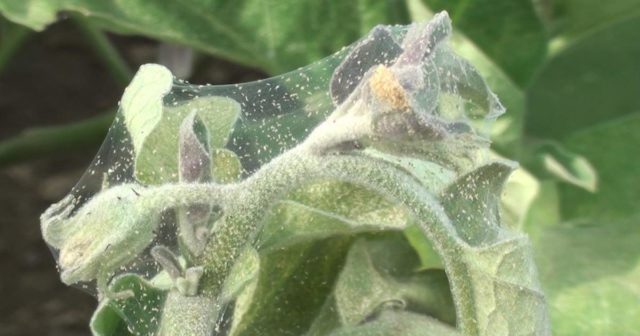
Description and life cycle of the pest
The spider mite is an arachnid with a convex upper body and four pairs of legs. It is difficult to see what the pest looks like with the naked eye, since its average size is 0.5 mm.
Ticks gather in colonies, each of which has hundreds of individuals. The color of pests changes under the influence of external factors. They are usually gray-green in early summer and orange-red from late summer to early spring. In adults, two red eye spots are located near the head, and numerous setae cover the body.
The life cycle of a spider mite consists of several stages: an egg, a larva, a nymph, and an adult. The entire cycle takes 8-20 days or more.
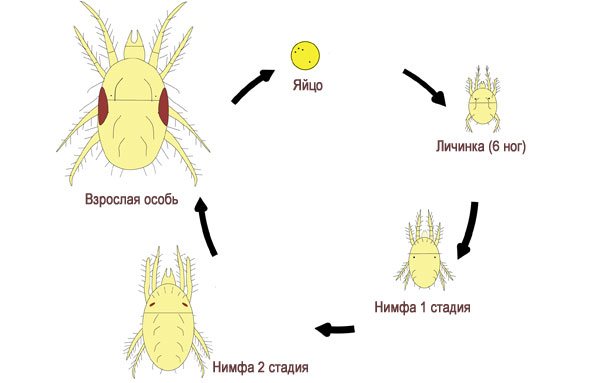

The most rapid development of the tick occurs at high temperatures (more than + 28 ° C). Another favorable factor for the accelerated reproduction of the pest is low humidity (no more than 55%). Adults move from plant to plant using cobwebs.
A fertilized female spider mite spends the winter on plant debris and under the peeling bark of trees. In the spring, when the temperature rises to 12 ° C, it moves to the surface and settles on the underside of the leaves (the first generation reproduces on weeds, the second and subsequent ones migrate to cultivated plants).
Weaving a dense web, the females of the tick lay greenish-transparent eggs, placing them one by one in the cobweb, which then become pearl-colored. The duration of this stage of development is directly related to the air temperature.
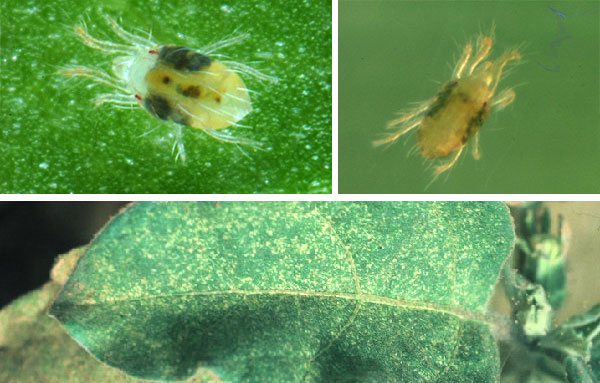

The development of the larval stage occurs in the interval of 8-20 days. The body is hemispherical, the length does not exceed 0.14 mm, there are three pairs of legs.
The nymph is almost similar to an adult, but smaller in size; there are already four pairs of legs at this stage.
The pest at all stages of development, with the exception of hibernating females, harms the plant. By piercing the epidermis from the underside of the leaf, it sucks out the juice of the leaves with grains of chlorophyll from eggplants, which gradually lose their vitality.
Why is the spider mite dangerous?
The spider mite is a very insidious and difficult to remove pest. The individual reaches the mature stage in just a week, after which it begins to produce its own kind. The colony grows exponentially, rapidly taking over new plants. During the season, an average of eight generations of spider mites are hatched in a greenhouse or in a garden bed. Considering that everyone lives for 7-30 days, it is easy to guess that without appropriate control measures, the plantings will soon come to an end.
The mites pierce the leaf tissue and feed on the plant sap. The plant quickly loses water and essential nutrients. Photos of a spider mite on eggplants were taken with a high magnification; in reality, an adult rarely exceeds 0.4 mm in length.
In addition to the fact that the spider mite itself causes colossal harm to the planting of eggplants, it is a carrier of many fungal and viral diseases, in particular:
- gray rot;
- late blight;
- anthracnose.
Eggplants weakened by a tick no longer have sufficient immunity and in most cases are affected by infections.
The whitish viscous web covering the leaves and stems of the eggplant does not transmit light well and slows down the process of photosynthesis. There is not enough organic matter, and the plant stops growing.
We must pay tribute to the vitality of the spider mite. During cold weather, these representatives of arachnids burrow into the ground and fallen leaves, climb into the cracks and frames of the greenhouse. Larvae and adult females are able to survive at temperatures down to -30 ° C. With the arrival of warmth, they crawl out of the shelters and attack the planted eggplant seedlings, which are especially vulnerable to pests and diseases.
Tips from experienced summer residents
Experienced gardeners recommend keeping your garden clean and tidy and being attentive to your plantings. In a clean and well-groomed garden, plants rarely get sick and have strong immunity.
Here are some tips to help you deal with a tick:
- It is better to pluck the damaged parts of the seedlings without regret.
- Do not rush to use strong chemicals. It is better to resort to their help only with a severe defeat.
- It is useful to spray the seedlings with a solution of ammonia (2 tsp per 1 liter of water).
- The web must be removed immediately.
- Strongly increase the humidity (at 90-95%, the eggs die).
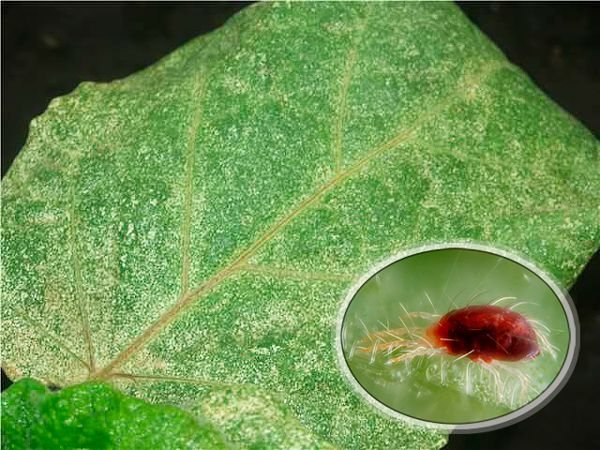

How to process eggplants from spider mites
You can get rid of spider mites on eggplants using pesticides, biological and folk remedies. Each method has its own pros and cons.
Eggplant spider mite chemicals
Eggplants, like other crops, are treated against spider mites with solutions of acaricides. This is a group of chemicals that destroy herbivorous mites.
Comment! The word "acaricides" comes from the Greek words "acari" - "tick" and "caedo" - "to kill".
The table below describes the most popular and effective drugs appreciated by gardeners.
| Name | Active substance | Features of the |
| "Actellik" | Pyrimiphos-methyl | Universal organophosphorus insectoacaricide of contact and intestinal action. When a spider mite enters the body, it disrupts the work of its vital organs. With systematic use, it can cause addiction in the pest. |
| "Envidor" | Spirodiclofen | Insectoacaricide contact action of a new generation. The drug does not cause cross-resistance, is effective for populations resistant to other acaricides, and kills ticks at any stage of development.Possesses high adhesion |
| Sunmight | Pyridaben | A highly effective Japanese drug that acts at all stages of spider mite development. The stoppage of all types of pest activity can be observed after 15 minutes. Ticks fall into a coma, and can no longer harm the eggplant plantings. |
| "Neoron" | Bromopropylate (isopropyl-4,4'-dibromobenzylate) | Contact acaricide, effective at all mobile stages of spider mite development. Does not lose its properties at low and high temperatures. Safe for bees and other beneficial insects |
| "Karbofos" | Malathion | Organophosphorus preparation of contact action. It affects the tick only when it hits the body of an arthropod. With regular use, spider mites develop immunity |
A warning! When working with pesticides, it is imperative to use personal protective equipment.
Biological remedies for spider mites on eggplants
Biological products for combating spider mites on eggplants have the same effectiveness as pesticides, however, they are less aggressive to the environment and are not dangerous to humans and animals.
Many bioacaricides are based on beneficial live microorganisms:
- bacteria;
- mushrooms;
- viruses.
Another component of bioacaricide is plant extracts, which act as fertilizers and fungicides. Using biological products on eggplant, you can immediately solve three problems:
- get rid of the hated spider mite;
- feed the plants;
- to carry out the prevention of fungal diseases.
| Name | Active substance or living culture | Features of the |
| Fitoverm | Aversectin C | A powerful product that shows results within five hours after spraying. Protection lasts for 20 days. Three days after the last treatment, the eggplants are edible. Due to the presence of the adjuvant in the protected soil, consumption can be significantly reduced |
| "Vermitek" | Abamectin | Bioinsectoacaricide of contact-intestinal action. Does not possess phytotoxicity. Has a long protection period - up to one month |
| "Akarin" | Avertin N | Biological product of intestinal action. Differs in a high speed of exposure to pests. Already 8-16 hours after treatment, the tick stops feeding and loses its motor activity |
| Apollo | Clofentesin | It has an ovicidal effect and is effective at all stages. The toxic effect lasts for 30 days. Not dangerous for predatory mites and beneficial insects |
| "Bitoxibacillin" | Spores of Bacillus thuringiensis var. thuringiensis | Not a phytotoxic biological product. Can be used at any stage of plant development. The fruits are allowed to be eaten five days after processing |
An extraordinary biological method for combating spider mites is considered to be the cultivation of carnivorous ticks (Phytoseiulus persimilis, Amblyseius californicus) on the site. They are sold at many garden centers. The gardener can only release them on the eggplant foliage. One hunter mite destroys 4-6 adult spider mites and about 10 eggs per day. When there is no suitable food left, the acariphages die.
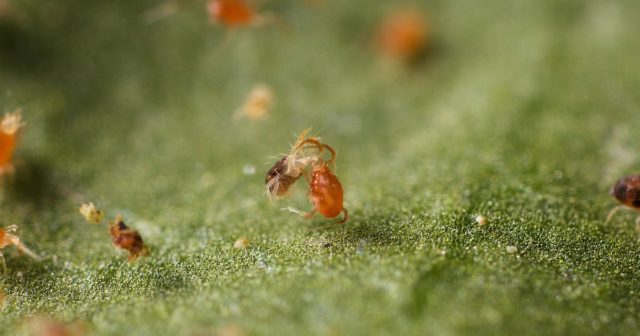

Folk remedies for spider mites on eggplants
The use of folk remedies is advisable if chemicals and biologicals cannot be used or they are not at hand. Such methods are effective for small tick infestations, as well as for complex pest control. Their action is slower and more gentle; they are not dangerous for humans and pets.
Garlic
Crushed garlic cloves (3-4 pcs.) Insist in 1 liter of water for two days. Before processing, the infusion is diluted with water 1: 1. In calm dry weather, the tops and the surface of the soil are sprayed.
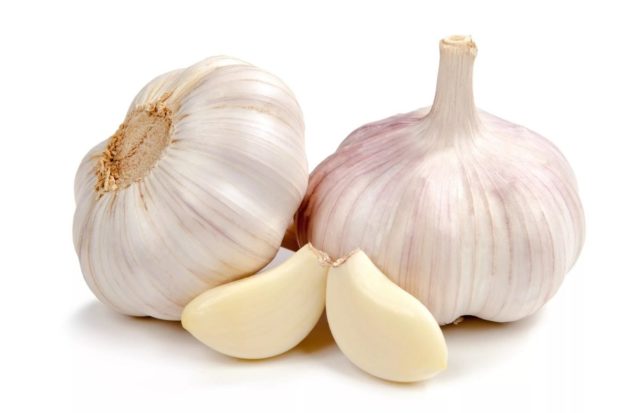

Onion peel
Onion peel in the amount of 100 g is poured into 5 liters of water, covered with gauze and left in a cool place for five days.Planting eggplants is sprayed after watering, after shaking the onion infusion.
Advice! For better adhesion to the leaves, you can add a little laundry soap to the infusion.
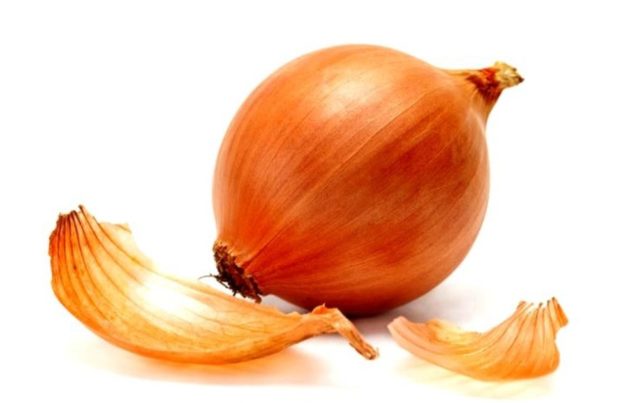

Mustard
To obtain a mustard infusion against spider mites, 60 g of powder is diluted in 1 liter of water. After three days, it will be ready for use.
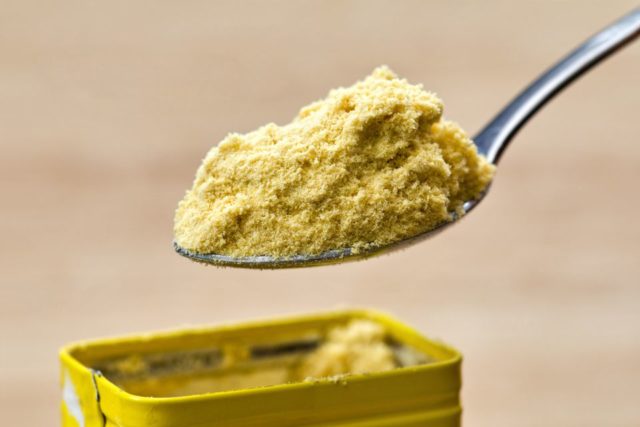

Alder leaves
Dry or fresh alder foliage (200 g) is steamed with boiling water (2 l) and simmered for half an hour. Then the broth is cooled and allowed to brew for 12 hours, after which it is filtered and sprayed with eggplant.
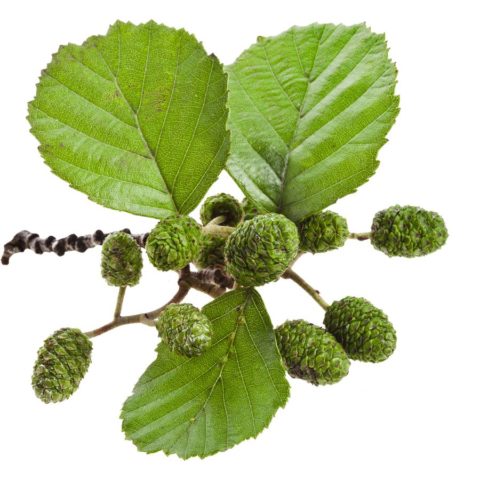

Dandelion
One of the quickest ways to make an eggplant mite infusion is to use a common dandelion. The foliage and rhizomes are crushed, poured over with boiling water and left for three hours. For 1 liter of water, you need 100 g of grass. The filtered, cooled infusion is sprayed with eggplant bushes, without diluting it with water.


Tobacco dust and ash
Tobacco dust is mixed with wood ash in equal proportions. The dry mixture is sprinkled on the bushes twice over the summer. 100 g of powder is consumed per 1 m².
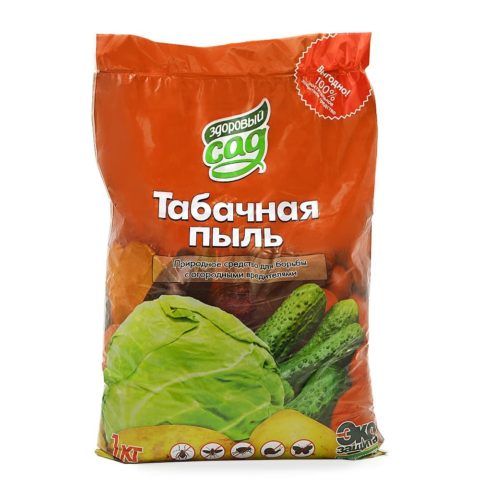

Green soap
Green soap contains potassium salt, fatty acids and vegetable oils. Dilute 400 ml of the drug into 10 liters of water. Laundry soap diluted in water (20 g per 1 liter) is also used to wash the leaves. Many gardeners are advised to spray the eggplant plantings with a solution of sulfur-tar soap (100 g per 10 l).
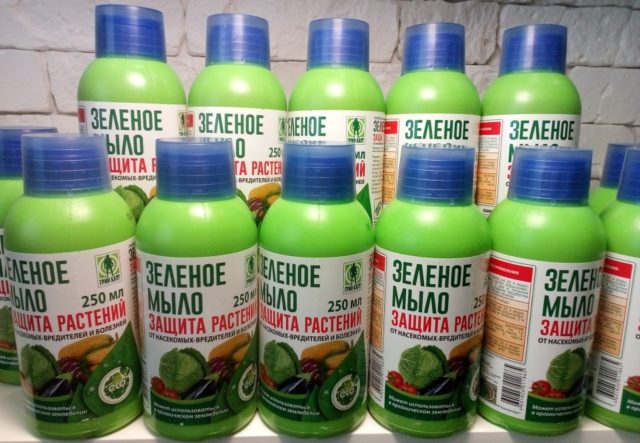

Ammonia
To prepare a solution of 1 tbsp. l. ammonia is stirred in 10 liters of water. Plants are sprayed, trying to get not only on the top, but also on the back of the leaves.
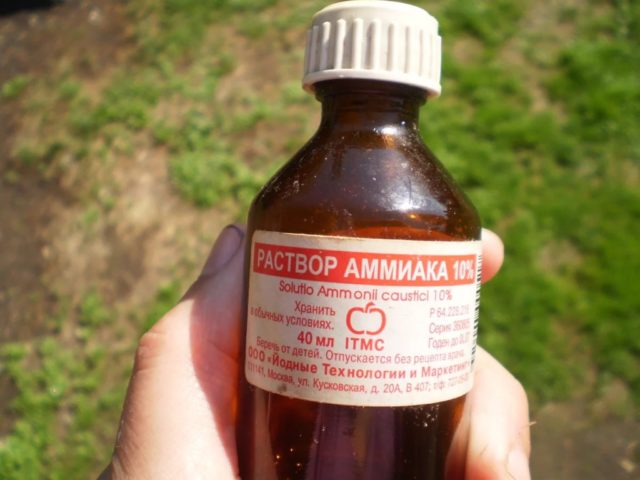

Important! All treatments, regardless of the method of struggle, must be carried out after mechanical washing off of cobwebs and ticks with a cotton swab, and complete drying of the surface of the leaves.
Use of insectoacaricides
Chemical or biological products for pest control.
When choosing a drug, it is better to take more modern developments, since they are less toxic and have greater safety of 3 or 4 classes, in contrast to 1 or 2 classes, provided that all the prescribed safety measures are observed. And the tick strives to keep up with progress and itself, too, continues to improve all the time. One does not take it, then another.
Types of insectoacaricides: Apollo, Actellik, Neoron, Omayt, Fufanon, Antikleshch, Sunmite, Floromite, Oberon, Flumite, colloidal sulfur.
Important! It should be remembered that insecticides do not work against ticks, because ticks are arachnids. Here, the use of insectoacaricides or acaricides is necessary.
Agrotechnical measures to combat spider mites on eggplants
The spider mite is active and multiplies rapidly under certain environmental conditions. Low humidity (less than 55%) and high temperature are most favorable for it.
An important agrotechnical measure in the fight against spider mites is digging the soil near the bushes to a depth of 5-8 cm. Row spacings are plowed by 10-15 cm.
To maintain the required soil moisture, you need to adjust the eggplant watering regime. Young plants are watered with 1 liter under a bush twice a week, adults - once a week, spending 2-3 liters. When the eggplants are in the stage of maturation of the ovaries and are actively bearing fruit, watering is carried out 2-3 times a week.
After the moisture is well absorbed, the soil is loosened, while removing the weeds. Mulch from compost or grass is poured under the bushes, the layer height should be at least 8 cm. Gradually re-heating, it will create a moist and warm environment in which the ticks will be uncomfortable.
How to fight in a greenhouse and open field
In a greenhouse, fighting a spider mite is a little easier. It is easy to control humidity and air temperature here. Sometimes even simple preventive measures and folk methods are enough.But with chemicals in the greenhouse, you need to be careful. Strongly toxic substances cannot be used categorically. Colloidal sulfur is great for a greenhouse.
In the open field, it is possible to control climatic conditions only partially: to cover the plantings from rain or strong winds, or to protect them from animals.
At the same time, it is permissible to use any drugs on the street. But it is better to give preference to low-toxic ones, because poisons also affect the plant.
Preventive actions
Prevention of spider mites in closed and open ground is somewhat different. For greenhouses, the following rules must be observed:
- The greenhouse should be regularly ventilated, the eggplants should be sprayed with warm water.
- Before planting and after harvesting, the soil in the greenhouse must be disinfected.
- Many experienced gardeners recommend annually changing the top layer of soil in the greenhouse - this is where the spider mite likes to winter.
- To destroy pests in the fall, a smoke bomb is placed in the greenhouse and all doors and vents are closed.
- You can walk along the frame of the structure with a blowtorch, only very carefully so as not to scorch or melt anything.
In open ground conditions, it is important:
- Observe the crop rotation.
- In autumn and spring, dig up the soil by at least 20 cm, applying organic fertilizers and copper sulfate.
- Carry out preventive treatments with onion, garlic or soapy water four times per season.
Prevention of the appearance
Preventing the appearance of a dangerous insect is easier than getting rid of it. It will be possible to avoid contamination of eggplants by following simple preventive rules:
- Planting calendula, chamomile, marigolds in aisles,
- Digging up the earth and removing the remnants of the bushes from it, the old plants are thrown away.
- Disinfection of greenhouses, hotbeds.
- Regular removal of weeds.
- Spraying the eggplant with warm water.
- During the growth of the crop, constant ventilation of the greenhouse.
Compliance with preventive measures will reduce the risk of a harmful insect.
A spider mite is a dangerous pest that can destroy all eggplant bushes in a short time. Measures taken quickly will get rid of the insect and preserve the crop. The choice of a remedy for removing ticks depends on the preferences of the gardener and the degree of disease in the bushes.
Folk remedies
They are used as an independent method of struggle or in addition to others.
- Dilute 1 teaspoon of ammonia in 1 liter of cold water. Spray once a week. If the dosage is exceeded, the leaves turn yellow, the eggplants may dry out. It is recommended to carry out the processing in the evening.
- In 1 liter of water, dilute 2 teaspoons of hydrogen peroxide. Spray the plant. The procedure is repeated after 3 days.
- Wood ash, laundry soap are added to the water. Concentration does not play a special role. Spray on eggplants. The beds are sprinkled with dry ash.
- Pour boiling water over celandine, dope, chamomile, garlic, onion peel. Insist for at least a day. A small amount of soap is added. Spray on eggplants.

